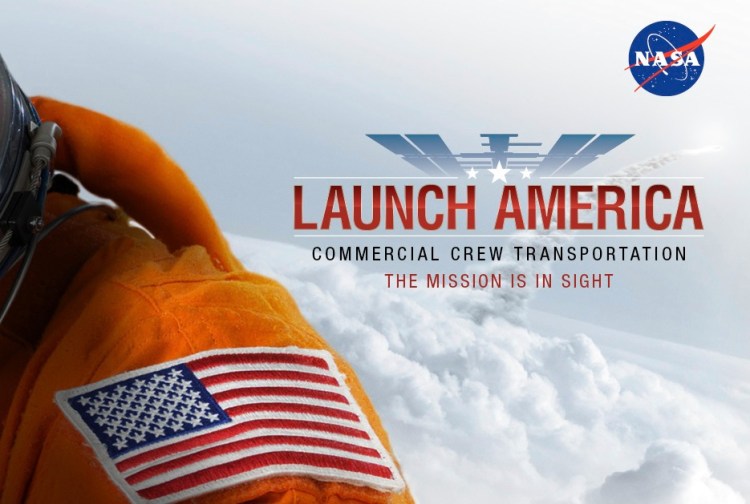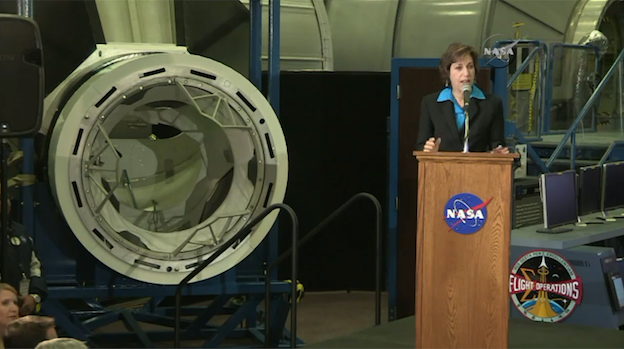Boeing and SpaceX have completed initial milestones as the two companies work toward providing NASA with the first new American crew transport vehicles in decades.
Today, in a live event at Johnson Space Center in Houston that was broadcast online, NASA, Boeing, and SpaceX provided the first new information about the Commercial Crew Program since the space agency chose the two companies as the providers of future crew vehicles.
The upshot: Boeing has made major progress towards the design of its program’s ground control technology, while SpaceX has built most of a system for aborting launches while still on the pad.
In addition, NASA estimates that the per-seat cost of an American manned mission to the International Space Station is likely to come in at around $58 million, and that when the development is completed, the space agency will have invested about $5 billion towards ending America’s reliance on Russian transportation.
“I don’t ever want to have to write another check to Ruscosmos,” NASA administrator Charles Bolden said today, speaking of the Russian Federal Space Agency.
In September, NASA selected Boeing and SpaceX as the two contractors to build America’s next crew transportation vehicle, a package that includes spacecrafts, rockets, and more. The so-called space taxis — Boeing’s CST-100 and SpaceX’s Crew Dragon spacecraft — will carry NASA astronauts to the International Space Station (ISS), allowing the United States to cease contracting with the Russians for all crew transport missions into space. The plan is for NASA to begin making manned trips to the ISS using these spacecraft by 2017.
The contracts left a third company that had bid to be involved in the space taxi program, Sierra Nevada, out of luck. Earlier this month, the U.S. government denied a protest by Sierra Nevada that the space taxi bidding process had been unfair.
Until now, said Kathy Lueders, the manager of the Commercial Crew Program, NASA has been unable to issue much in the way of updates on the efforts due to the protest. But with that out of the way, the space agency, and its partners, can now begin to move forward, she said.
During today’s event, Boeing Space Exploration vice president and general manager John Elbon said Boeing has completed the critical design review of the ground segment of its CST-100 program. That includes the mission operations systems, the control center, and the training systems — including the trainers, simulators, and ground software used to plan, train, and fly the crew, he said.
In addition, Boeing has begun construction on the crew access tower for the Atlas V rocket, which the company will use to launch the CST-100 into space. Boeing has also begun the remodeling and modernization of the manufacturing facility at Kennedy Space Center in Florida where the hardware that will form the test CST-100 will be built and delivered later this year.
He also said Boeing plans on delivering the flight software later this summer, as well as a simulator running it, and that 26 of the 34 flight displays will be included, allowing the crews to interface with the system.
Elbon said Boeing will undergo a “critical design review” in March that, if everything goes well, will allow the company to move forward with manufacturing the CST-100.
For its part, SpaceX has completed a certification baseline review, said Gwynne Shotwell, the company’s president and COO. SpaceX has also largely completed a build of a pad abort vehicle, Shotwell said, and will conduct a pad abort test in the next month or so.
The company anticipates sending an uncrewed mission to the Space Station in late 2016, and the first manned Dragon mission “shortly” thereafter, in 2017, she said.
SpaceX plans on making more than 50 flights of the Falcon 9 — the rocket that will transport the Dragon capsule — before ultimately carrying the first crew, Shotwell said.
She also said that although SpaceX ultimately wants to be do propulsive landings of the Dragon, the company will be certifying water landings first.
Mars in under 20 years?
Although Boeing and SpaceX are both providing NASA commercial crew transport services, the space agency is expected to send the CST-100 to the Space Station prior to the Dragon, said Lueders. That’s because of the differences in lead times of the two programs and the time required to ready the services.
Ultimately, while the initial goals of the commercial crew transport program is to take astronauts to the ISS on American-made and owned vehicles, the long game is Mars. Everything the program is working on, said Bolden, the NASA administrator, is about getting us to Mars.
And while people have said for years that getting to Mars is 20 years in the future, Bolden said that for the first time, he believes that timeframe is no longer true. Thanks to progress being done on America’s commercial crew transport program, Bolden said, “I think we’re on the verge of breaking the 20-year mark.”




